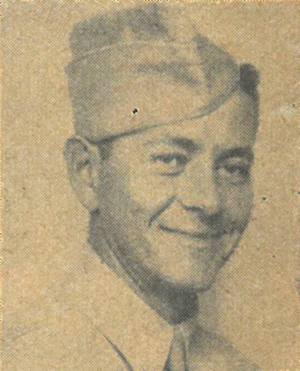

Remember...
Clarence Garold Van Horn
1912-1944
"You ask what is our aim? I can answer in one word: Victory. Victory at all costs . . . . For without victory there is no survival."
Winston Churchill
Clarence Garold Van Horn was born on March 18, 1912, in Monongah, West Virginia, to Mary Alice King Van Horn and George Washington Van Horn. The large family included Clarence's brothers and sisters, William, Fred, Wanda, Gail, Jay, Harry, Goldie, Florence, and Ruth. All were at home in 1920, according to the Federal Census for that year. Clarence attended Monticello Grade School. Mr. Van Horn was a machine operator in a coal mine, as was his son, Fred. Wanda was a salesclerk in a general store. In 1930, William, Clarence, Goldie, and Florence were still living at home. Mr. Van Horn was a salesman at that time, and Clarence was a laborer in a box factory.
On October 16, 1940, Clarence Van Horn registered for military service in Clarksburg. He was 28 years old and listed his mother as the person who would always know his address. He worked for Lange and Crist Box and Lumber Company in Clarksburg. On April 21, 1942, Clarence enlisted in the U.S. Army. He served at Camp Chaffee, Arkansas, and Camp Cooke, California, according to an entry made for him in Young American Patriots. Corporal Van Horn was placed with Company A of the 708th Amphibious Tank Battalion. On January 31, 1944, Clarence Van Horn's name appears on the passenger manifest of the LST 224 transport ship. He arrived in the Marshall Islands from Pearl Harbor.
The amphibious tank units had a very important role for transporting materials to the island, as well as troops. The landing force from the 708th, alone, was composed of 68 amphibious tanks. Given the challenges of the duty of overcoming enemy fire, water, and land transport, and unknown conditions caused by the reefs and sand, the losses on that day were inevitable. Only one tank from Company A did not make it ashore. The tank burned offshore. Conditions on shore were even more challenging, where anti-tank trenches, heavy enemy artillery fire, and a challenging barrier of rocks and trees prevented some troops from reaching their goal. There were many casualties that day. ("Army Amphibian Tractor and Tank Battalions in the Battle of Saipan, 15 June - 9 July 1944," U.S. Army Center of Military History, accessed 14 November 2021, https://history.army.mil/documents/wwii/amsai/amsai.htm.) One was Corporal Clarence Van Horn.
The mission was finally accomplished on July 9, 1944, with the Allies victorious and the island claimed in their name. From the four amphibious units that participated in the attack on the island, 41 personnel were killed in action and 14 were missing. ("Army Amphibian Tractor and Tank Battalions in the Battle of Saipan 15 June - 9 July 1944.")
At the time of Clarence Van Horn's death, one of his brothers served in the Army, and his father, George, had been dead for a few months, having died the previous February. ("Van Horn Is War Victim," Clarksburg Telegram, 2 April 1944.)
Article prepared by Cynthia Mullens
November 2021

West Virginia Archives and History welcomes any additional information that can be provided about these veterans, including photographs, family names, letters and other relevant personal history.